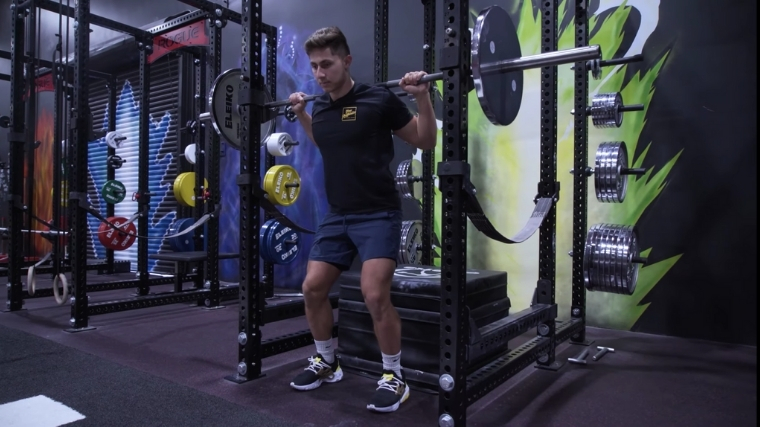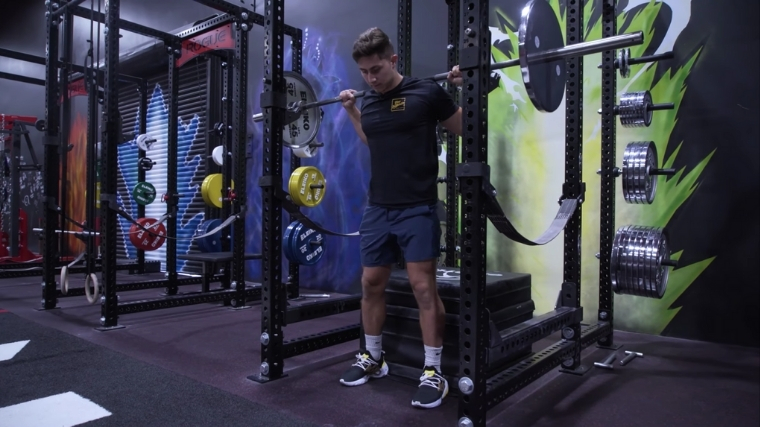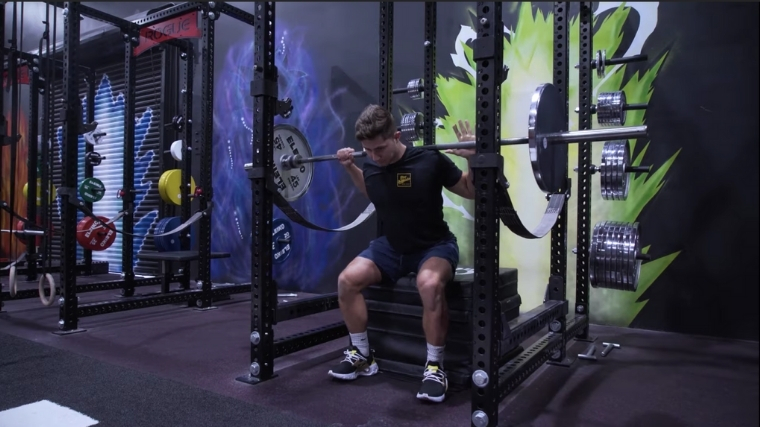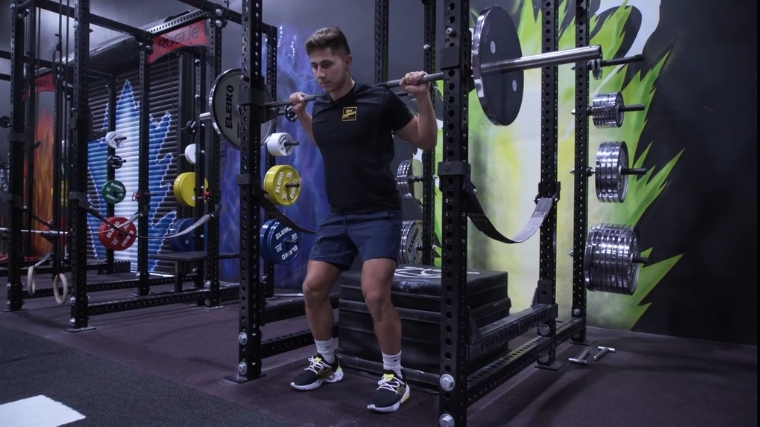The box squat is thought of as a move for hardcore powerlifters looking to eke out every ounce of progress from their squat. Actually, it’s a great move that any lifter can do to improve the back squat, add muscle to the legs, and get acclimated to heavier loads. Best yet, it’s simple to do: Place a loaded barbell on your back, squat to a box that has you sitting to parallel, pause, and then explode back up.
Below, we discuss the box squat in detail, covering box squat technique and set up variations, the muscles worked, and the benefits that lifters can gain from integrating this move into their workout program.
- How to Do the Box Squat
- Box Squat Sets and Reps
- Common Box Squat Mistakes
- Box Squat Variations
- Box Squat Alternatives
- Muscles Worked by the Box Squat
- Benefits of the Box Squat
- Who Should Do the Box Squat
- Frequently Asked Questions
Editor’s note: The content on BarBend is meant to be informative in nature, but it shouldn’t take the place of advice and/or supervision from a medical professional. The opinions and articles on this site are not intended for use as diagnosis, prevention, and/or treatment of health problems. Speak with your physician if you have any concerns.
How to Do the Box Squat
A box squat is defined as any squat variation — front squats or safety bar squats, for example — that have the lifter pause with their butt on a box and then drive back up.
Generally, the depth of the box squat is until the lifter’s thighs are parallel to the floor. But some folks set the boxes higher or lower, depending on their training goals.
Here’s a step-by-step guide on how to do the box squat.
Step 1 — Get Set

Set yourself up in a squat rack in the same manner that you would when performing back squats. Once you have determined your box height, set the box a few feet back away from where the barbell is racked to ensure you have enough space to walk the barbell out of the rack. Sit down on the box. Stand up without hitting anything.
Form Tip: You can adjust the box height to address your specific needs and goals.
Step 2 — Unrack the Barbell

Brace your core and unrack the barbell. Step back until you’re in front of the box, with your calves nearly touching it.
Form Tip: If you can do so, turn the box or bench slightly so that the edge is underneath you. This allows you to better hover over the bench or box for a better range of motion.
[RELATED: Best Barbells]
Step 3 — Push the Hips Back and Squat Down

Now, sit your hips back — but not too much — and squat down until your butt is on the box or bench. Stay tense as you squat down. Think about sitting on a soft pillow. You do not want to sit down and lose all tension.
Form Tip: The more you drive your hips back, the more emphasis is placed on your hamstrings, glutes, and erectors.
Step 4 — Briefly Pause, then Stand Up

Once your butt is on the box, pause. The pause is meant to eliminate momentum — like the dead stop during a Pendlay row — so that the lifter must use all his or her force to stand up. Stand up and pause again at the top for a beat before starting the next rep.
Form Tip: Do not bounce up off the box or bench. Stay tight as you take a moment and then explode back up.
Box Squat Sets and Reps
The box squat isn’t typically a move that you’ll max out. Nor is it necessarily the biggest muscle-builder out there — you’ll typically want moves that go through a full range of motion for max muscle-building potential. Still, the box squat can teach many lifters to squat a lot deeper than they’re used to. This will undoubtedly be a boon for both strength and muscle gains, not to mention refining your technique.
- For Technique: Perform four sets of 10 reps with light weight.
- For Muscle: Do three to four sets of six to 10 reps with moderately-heavy weight.
- For Strength: Try for four to five sets of four to five reps with heavy weight.
When you’re first learning the box squat, make sure you’re not lifting very heavy — think around 50 percent of your one-rep max. Once you’ve learned the ins-and-outs of the move, you can go a lot heavier. Just make sure you’re confident in your depth and perform all the ramp-up sets you need before loading on all the plates.
Common Box Squat Mistakes
The box squat arguably makes your regular barbell squat a bit easier. You can use it to build confidence at the bottom of your depth and to teach yourself where a good depth is for your own body. That doesn’t mean you can’t make mistakes while training the box squat. Here are some common mistakes we see with this move.
Incorrect Depth
To perform a box squat effectively, you have to know why you’re doing it. If you’re trying to increase the range of motion that you’re comfortable with, you need to sink down to a low box. Start with a higher one if necessary, then transition gradually to a lower box. Eventually, you should be sinking to a box that’s lower than your current range of motion for maximum effectiveness.
Sitting Too Long
It’s important to take a pause at the bottom of your box squat. That said, you want to maintain tension at the bottom range of motion. To do so, you’ll generally want to avoid fully sitting on the box.
While fully sitting for a brief pause can help you completely eliminate momentum — which is what makes this move so effective — it’s important to make sure you’re not sitting for so long that you’re taking tension out of the move entirely. This is actually dangerous — especially as you use more weight — and can lead to compressive and shearing force on your spine. The box is not there to hold you up but rather act as a guide for depth.
Not Pausing
If you don’t pause at all at the bottom of your box squat, you’re also taking out its major benefits. Much like bouncing your deadlifts, you’ll ironically use momentum by bouncing your butt off the box. This can have benefits if you’re looking to give yourself more mental confidence in deeper ranges of motion. If you’re trying to build max strength, pausing for a beat will work wonders.
Box Squat Variations
Below are three box squat variations that can progress or regress the box squat based on the lifter’s needs and goals.
Pause Box Squat
The pause box squat is done just like the standard box squat. However, the lifter uses a deliberate pause.
[Read More: The Best Quad Exercises and Quad Workouts for Muscle Gain]
During this pause, it is essential that you stay braced and loaded in your quads and hips despite being static at the bottom of the squat. By pausing, you can minimize the stretch reflex, and develop concentric strength and overload the eccentric phase (controlled lowering).
Low Box Squat
Training the box squat exclusively can have its limitations, especially if looking for maximal muscle growth. That generally requires you to move through a fuller range of motion.
By progressively lowering box heights, you can take lifters who struggle to achieve stable low positions and transform them into full-range-of-motion squatters.
Box Squat with Accommodating Resistance
By adding resistance bands or chains to your box squat, you can add the benefits of accommodating resistance to this powerful, strength building squat variation.
With chains or resistance bands, you can increase strength in your sticking points and address power output.
Box Squat Alternatives
Can’t find a stable box and don’t want to haul a weight bench into the squat rack? No problem. Here are three box squat alternatives to increase your muscular development and strength.
Hatfield Squat
The Hatfield squat is an assisted squat variation that can help address sticking points similar to the box squat.
This can be done with a safety squat bar and inside a squat rack. Programming the Hatfield squat can be done similarly to the box squat and is often done with slightly greater relative loads than that of the back squat.
½ to ¾ Depth Back Squat
Instead of using a box, you can self-limit your range of motion. By limiting your range to a half or three-quarters of your usual depth, you can iron out a lot of squat sticking points.
Though, this is difficult and may lead to bad squatting habits. Be sure to use a spotter if you’re going heavier.
Goblet Squat
The goblet squat is an excellent squat variation, especially for beginners. The front-loaded position will keep you upright and reinforces proper form.
To perform the goblet squat properly, make sure you’re sinking to depth as best you can. For many lifters, this may mean adopting more of a sumo stance to accommodate your elbows between your thighs.
Muscles Worked by the Box Squat
As a squat variation, the box squat works pretty much every muscle in your lower body to some degree. Here are the main muscles worked by the back squat and their functions.
Quadriceps
Your quads extend your knees, and so they’re primarily engaged during the lifting phase of this movement. The higher the box you use, the shorter your range of motion. This will deemphasize your quadricep’s engagement.
Hamstrings and Glutes
Your hamstrings and glutes are active in the box squat, yet their involvement may vary based on box height and barbell position. In general, the lower the bar is on the back, the greater amount of hip flexion and extension occurs throughout the moment, increasing hamstrings and glute engagement.
Benefits of the Box Squat
Here are four benefits of the box squats that all lifters — competitive or not — can gain from doing box squats.
Increase Concentric Strength
By pausing on a box at the bottom of a squat, the lifter takes away all of their momentum. In doing so, the lifter must rely solely on concentric strength to move the weight, which will translate to a stronger lockout during standard back squats (not to mention bigger quads).
Posterior Chain Development
When performing box squats, a lifter engages their glutes and hamstrings. This increased posterior chain activation and development will significantly impact non-box squat strength and lower body strength and power output.
Address Sticking Points in the Back Squat
Sticking points occur throughout various phases of the squat for most lifters. However, common areas are at or slightly above parallel.
[Read More: The Best Quad Exercises and Quad Workouts for Muscle Gain]
The box squat can be set to a specific depth based on the lifter’s needs to train and develop strength, skill, and confidence working through (or just below) the sticking point range of motion.
Train Around Aches
If you have an overuse ache or a serious injury, you should generally consult a doctor before squatting. However, the reduced range of motion and the pause of box squats make this a more accessible move for folks with achy knees or lower back.
Who Should Do the Box Squat
Box squats are a more targeted variation of the traditional squat, but competitive and general lifters alike can still reap this great exercise’s benefits. Here’s who should consider dropping it low (well, not too low) to a box.
Strength and Power Athletes
- Powerlifters/Strongmen and Strongwomen: The goal of powerlifting is to hoist as much weight as possible. As one gets stronger, progress begins to slow. Specifically, lifters can run into issues at certain parts of the lift — typically, the bottom, middle, and top. Powerlifters can use the box squat to strengthen the top portion, or lockout, of the squat. Also, because one can typically lift more weight on the box squat, it helps powerlifters and strongmen acclimate to heavier loads. For strongmen specifically, high box squats can help them pick a yoke more easily.
- Weightlifters: Though not completely useless, a weightlifter won’t typically perform box squats. Regular, deep back squats translate far better to the snatch and clean & jerk.
General Fitness
Generally speaking, most individuals would benefit from learning how to squat in the full range of motion. That said, box squats can be a tool to establish hip drive and loading mechanics.
Box it Out
Boxes aren’t just for jumps anymore, and weight benches aren’t just for lying down on. Instead, try setting up a weight bench or plyo box in a squat rack the next time you’re working through a squat plateau. Whether you’re just learning to perform a barbell squat to depth or you’re looking to lift as much weight as you can, sitting your butt down (briefly) can help get you to your goals.
FAQs
It’s normal to have a lot of questions about adding a new move to your training regimen. Check out these questions to satisfy your curiosity.
Are box squats bad for my knees?
No. Squats in general aren’t bad for your knees. (That said, always consult a doctor before squatting if you do have a knee injury.) Issues arise when people load the exercise excessively without first addressing the full range of motion training to ensure pain-free movement, proper joint stabilization, and muscular development.
If I can squat to full depth, should I box squat?
If you’re simply looking to lose fat, gain muscle, and improve conditioning, then full range of motion squats are fine.
However, if you’re a strength athlete who needs to express squat strength specifically in limited or partial ranges of motion (powerlifting), using the box squat at various times can help improve performance.
What height should I box squat too?
This can vary based on outcome-specific goals, however, typically the depth is to parallel or slightly below parallel. Some athletes who are looking to improve jump height may squat to 60-70 degrees of knee flexion to mimic jumping mechanics.
When looking to address sticking points, you can set your height just below the sticking point to be able to work through that difficult range. If your goal is maxima leg growth (muscular development), it may be best however to perform squats in the fullest range of motion, making box squats not as applicable in that scenario.
Featured image: Ivan Kochergin/Shutterstock